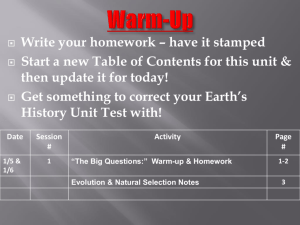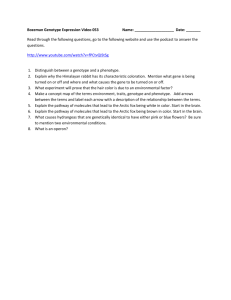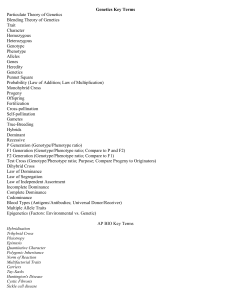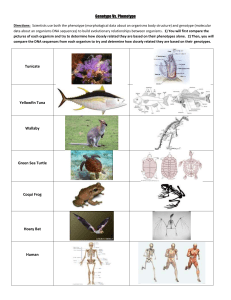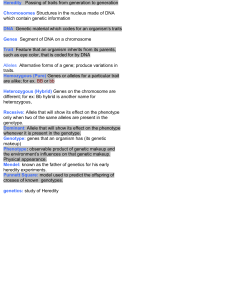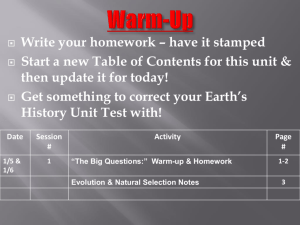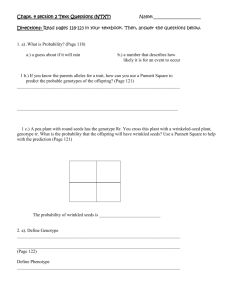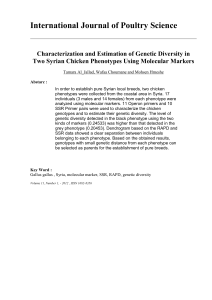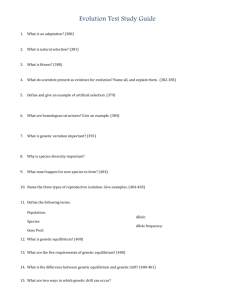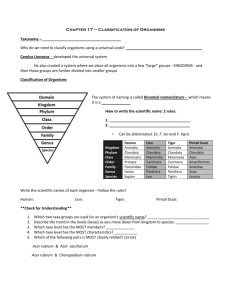Warm-Up - mssarnelli
advertisement
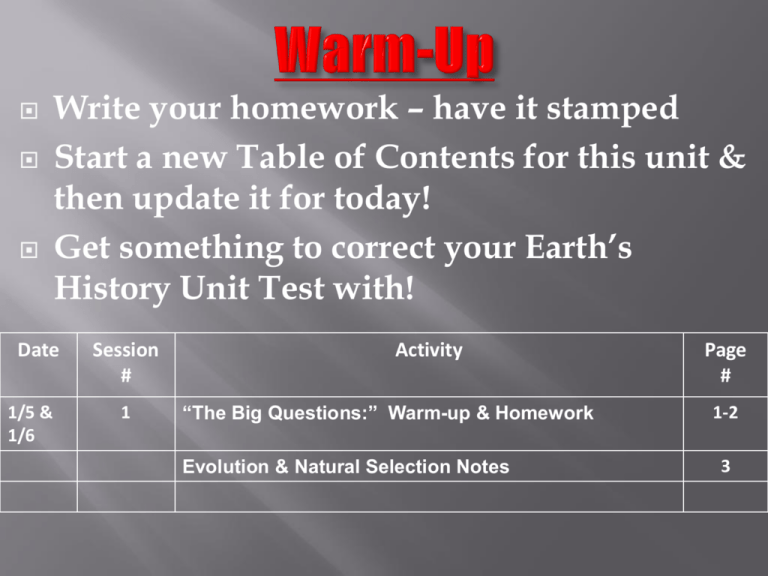
Write your homework – have it stamped Start a new Table of Contents for this unit & then update it for today! Get something to correct your Earth’s History Unit Test with! Date 1/5 & 1/6 Session # 1 Activity “The Big Questions:” Warm-up & Homework Evolution & Natural Selection Notes Page # 1-2 3 “THE BIG QUESTIONS” What is evolution? How does biological evolution happen? What is the evidence to support biological evolution? What do we do with this evidence? Take a few minutes and… Write down any and all questions that come to your mind about evolution that you would like answered. • • Now, go through your list…chose your top 5 questions to answer for homework! What is evolution? How does biological evolution happen? The voyages of Charles Darwin & Alfred Russel Wallace led each scientist to independently discover the natural origin of species and to formulate the theory of evolution by natural selection…making them the “Fathers of Evolution” Evolution – The process of change over time This change could be geological, biological…what else? How do they affect each other? Biological Evolution is a process driven by the changes in Earth…living things evolve in response to changes in their environment. This response leads to a change in genetic material that is passed through generations. This is the process of Natural Selection or “Survival of the Fittest.” There are 4 Principles of Natural Selection! Overproduction Definition: When an organism makes more offspring than the environment can support to ensure that at least some survive and reproduce Example: Variation Definition: Naturally occurring differences in traits due to differences in genetics - these variations or mutations get passed to offspring Example: Adaptation Definition: Inherited trait that gives an organism an advantage in its environment over other members of its species Example: Selection Definition: Organisms with an adaptation will survive and reproduce passing on the adaptation – this is Natural Selection, or “Survival of the Fittest” Example: Sea Horse Birth Video: https://www.youtube.com/watch?v=MsHCqrrU-Gk So how do animals and plants adapt to their environment over time? Elephant Adaptation Video - shows how evolution of the Earth affects the evolution of a species http://player.discoveryeducation.com/index.cfm?gui dAssetId=0B5B292A-983E-4327-A27DB647383BF293&blnFromSearch=1&productcode=US Objective: - Analyze each picture to find examples of the 4 principles of Natural Selection. Activity: - Each photo is numbered, so on your note guide next to each number write which of the 4 principles you see along with a justification for why you wrote that principle…there may be more than one! Sea Turtle Land Turtle VS. Create an additional example that could be added to our gallery walk by finding one ORIGINAL example of Natural Selection that we did NOT talk about in class, and create the informational poster about it! EXAMPLE: The warrior ant of Africa can learn to imitate the chemical signal from other ant colonies so they can invade and take over undetected! This is an example of adaptation because… Write your homework – get it stamped! Update your table of contents for today! Get your homework out to be checked, and be ready to share some of the answers you found! Date 1/7 & 1/8 Session # 2 Activity Biological Evolution: How Does it Happen? Page # 4 How does biological evolution happen? What is the evidence to support biological evolution? What is evolution? How does biological evolution happen? Species change over time in response to their environment. This response leads to a change in genetic material that is passed through generations, or the process of Natural Selection or “Survival of the Fittest.” What were the 4 Principles of Natural Selection? The 4 Principles of Natural Selection lead us through the process of biological evolution, but then how do we have so many different species on Earth? First of all, what is a species? Species – A group of organisms that can interbreed and produce fertile offspring Where did all of these different species on Earth come from? Speciation – over time, beneficial variations that are passed on through generations will accumulate and result in an entirely different organism - not just a variation of the original, but an entirely new species. What could cause organisms of the same species to evolve so differently? Isolation - if 2 populations of the same species are separated they cannot reproduce with each other causing different variations & mutations in each population due to environmental demands, and eventually 2 new species will evolve from the old species. Is all evolution natural? NO! Artificial Selection – (also known as selective breeding) is the process by which humans breed plants and animals for specific desirable traits Can you think of any examples? Galapagos Finches Watch the video & answer the questions on the note guide!! http://www.hhmi.org/biointeractive/origin-species-beak-finch Once you get your Chromebook, go to: http://www.hhmi.org/biointeractive/sorting-finch-species You will go through this activity without your headphones and see how well you are able to sort the different species of finches based on their song and appearance. You can work with your table partner, but you must each complete the half sheet of questions and turn it in for a grade! Once you have found the activity, click on ‘Start Click & Learn,’ and then begin to fill out your half sheet Write your homework – get it stamped! Update your table of contents for today! Get your Finch Sorting Activity off of the counter and tape it into page 5! Date 1/8 & 1/12 Session # 3 Activity Page # Finch Sorting Activity 5 Genotype Vs. Phenotype Notes 6 How does biological evolution happen? What is the evidence to support biological evolution? You will be faced with 3 challenges…will you survive? Based on the challenges of this environment, what traits or genetic variations are important in giving students the physical advantage or adaptation for survival? What if the environmental demands changed? What is the evidence to support biological evolution? What do we do with this evidence? The body structure and characteristics are dependent on the genetic code! In other words, the genetic variation leads to the physical adaptation! GENOTYPE – genetic code or DNA structure PHENOTYPE – body structures, physical characteristics or behavior Genotype (genetic variations) Phenotype (physical adaptations) Natural Selection Or “Survival of the Fittest” Based on just the phenotype…who do you think is more closely related and why? Who is more closely related and why? Using just the phenotype is hard…the hyrax is one of the elephant’s closest living relatives…but how would you ever know that? Each of the next slides will describe a scenario. I will read the scenario, and then you must quickly write an example of a PHENOTYPE that would give an animal in that scenario and advantage in survival. You will have 30 seconds to write as many things as you can on your paper! Scenario 1: Drought - There has been a drought and all of the grass has dried up and dies first, but the leaves on bushes and trees are slower to die…who survives the longest? Scenario 2: Predator is Approaching - A predator is approaching the herd, but is not hunting yet…who will know sooner and therefore have a better chance to escape? Scenario 3: Predator Fight - A predator has arrived. It is too late to run away or hide, the animals must fight off the predator…who has the best chance at fighting? Scenario 4: Blizzard - The weather becomes very cold. There is a blizzard and the land is covered in snow…who survives? Scenario 5: Human Factor -Humans frequently make rapid changes to the natural environment. Which characteristics would make a species most able to adapt and evolve to a rapidly changing environment? Rock Pocket Mouse Watch the video clip & answer the questions!! http://media.hhmi.org/biointeractive/films/natural_selection.html Again, the body structure and characteristics are dependent on the genetic code! In other words, the genetic variation leads to the physical adaptation! …but which one is really what helps a species survive? Write your homework – get it stamped! Quiz next class on Sessions 1-4…STUDY!! ALL work must be turned in by Friday! Answer key to vocab practice quiz will be on the wiki! Update your table of contents for today! Date 1/13 & 1/14 Session # 4 Activity Page # Genotype Vs. Phenotype Analysis Warm-Up 7 Evidence of Evolution Notes 8 Practice Quiz 9 What is the evidence to support biological evolution? What do we do with this evidence? What is genotype? What is phenotype? Which is really responsible for allowing a species to survive? What do we use phenotype and genotype information for? Organism Genotype Tunicate GTAAGCCGTTTAGCGTTAACGTCCGTAGCTAAGGTCCGTAGC Yellowfin Tuna GTAAAATTTTTAGCGTTAATTCATGTAGCTAAGGTCCGTAGC GTTTAATTAAAAGCGTTCCTTCATGTAGCTTCCACGCGGCGC Wallaby Green Sea GTATAATTAAAAGCGTTAATTCATGTAGCTTCCGTCCGGCGC Turtle GTAAAATTAAAAGCGTTAATTCATGTAGCTAAGGTCCGGCGC Coqui Frog GTTTAATTAAAAGATTTCCTTCATGTAGCTTCCACGCGGCGC Hoary Bat GTTTAATTAAAAGATTTCCTTCATGTGGCTTCCACGCGGCGC Human # of genetic bases in common with Tunicate 42 33 18 1. 2. 3. 4. Fossils Embryology Comparative Anatomy (homologous structures, analagous structures, vestigial structures) Molecular Biology Fossils – show change in a single species over time or similarities between species Evolution of the Modern Horse Embryology – shows similar developmental stages amongst different species Embryology Challenge: Embryos of a human, chicken, tortoise, fish, rabbit & salamander…which one is which? Homologous Structures – same anatomical structure but different function that arise from different organisms sharing a common ancestor Analogous Structures – different anatomical structure but same function that arise from common environmental demands Vestigial Structures – Anatomical remains that were important in an organism’s ancestors, but are no longer used in the same way Key to understanding how genetic traits are passed from one generation to the next! Scientists can tell how closely related organisms are – the difference in gene sequences between organisms is very small!! Both the phenotype & genotype are important for determining the relationship between organisms! Get a whiteboard, marker & eraser so we can practice with the different types of evidence! There are 5 scenarios and 6 choices & each piece of evidence is only used once! EXAMPLE: Humans, chimps, whales and bats all have the same bones in their arms, fins or wings. What type of evidence is this? How is this evidence of evolution? EXAMPLE: The human gene for your muscle protein is different from a monkey muscle protein in 4 places and different from a chicken in 25 places. What type of evidence is this? How is this evidence of evolution? EXAMPLE: Scientists find bones of a huge animal that doesn’t exist today, but it looks similar to a horse. What type of evidence is this? How is this evidence of evolution? EXAMPLE: Honey opossums lick nectar from flowers using a long tongue made of soft muscle, while butterflies lick nectar from flowers using a long tongue made of hard protein. What type of evidence is this? How is this evidence of evolution? EXAMPLE: Humans, rabbits and zebras all have an appendix, but the human appendix is much smaller than the other mammals because it doesn’t really use it anymore. What type of evidence is this? How is this evidence of evolution? Study for your Evolution quiz next class! ALL work must be in by Friday! Write your homework – get it stamped! Update your Table of Contents for today! Grab your Children’s Book off the counter! Review for your quiz – any questions? Date Session # 1/15 & 1/16 5 Activity Natural Selection Nemo Style Page # 10 20 questions around the room in 20 minutes! If you get 100% you will receive 10 extra credit points! You may use your notes and work together, but someone else will be grading your answers! Participation Grade: 100 = complete 70 = incomplete Last grade of 2nd quarter! Clear your desk except for your pencil! Folders up! When you finish, please put your quiz in the basket! Do make up work, extra credit, or play the Evolution Games listed on the half sheet. Write your homework – have it stamped! Update your Table of Contents for today! Tape your Evolution Quiz onto Page 11! Date Session # 1/20 & 1/21 6 Activity Page # Evolution Quiz 11 Biological Classification/Evolutionary Tree Notes 12 Evolution Cartoon Rubric 13 What do we do with this evidence of evolution? What do we do with this evidence of evolution? 1. Establish relationships between species 2. Biological classification – classify organisms based on taxonomy 3. Build evolutionary trees How do we know how related one species is to another? Using phenotype evidence (homologous, analogous, vestigial) Comparing genotype/DNA sequences (molecular biology) How do we identify and organize all of these different species? To classify organisms scientists use the similarities & differences among species gathered by analyzing their phenotypes & genotypes. Taxonomy – the science of naming and classifying organisms How do we represent this relationship? Evolutionary Tree – also known as a phylogenetic tree; it is like a family tree, but it shows the relationships between species branching back to common ancestors. What are the categories we use to classify an organism? Example: Humans Kingdom: Animalia Phylum: Chordata Class: Mammalia Order: Primates Family: Hominidae Genus: Homo Species: Sapiens • Which 2 animals are the most closely related, and how do you know? Racoon Cattle Fox Muskrat Kingdom Phylum Class Order Animalia Chordata Mammalia Carnivora Animalia Chordata Mammalia Artiodactyla Animalia Chordata Mammalia Carnivora Animalia Chordata Mammalia Rodentia Family Genus Species Procyonids Bovidae Procyon Bos Procyonlotor Bostaurus Canidae Cricetidae Vulpes Ondatra Vulpesvulpes Ondatrazibethicus • Using pages B51-B54 in the textbook, answer the questions at the bottom of the note guide with your table partner! Reading an Evolutionary Tree is similar to reading a family tree. Read the passage and examine the diagrams on the left, then answer the questions on the right. Lays eggs on land You will have the rest of the time to create a cartoon about any topic we have covered under Evolution. You may hand draw your cartoon, or use a website like Toondoo or Powtoon to complete and submit it by the due date! If you create an account be sure to write down your username & password!
